The day has come! The tiny chicks you ordered online months ago have finally arrived. After you get the little peepers set up and happy it’s time to figure out what the hell you have.
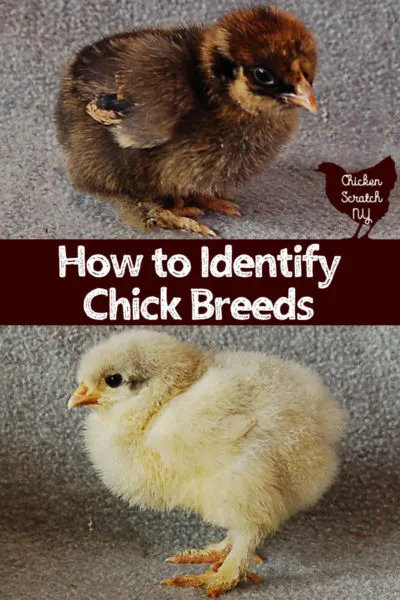
If you only ordered one kind of chicken this part is pretty easy. It gets harder based on how many types you ordered and if you got any random assortments.
These tips are also helpful for figuring out Mom and Dad when you hatch eggs from a mixed flock.
It’s like Maury but less sad and with more poop. Be warned, there’s a lot of poop in these pictures. The second I set the chicks down for pictures 75% of them pooped.
Turns out it’s also pretty tricky to take pictures of chicks. I apologize ahead of time that they’re all slightly unfocused.
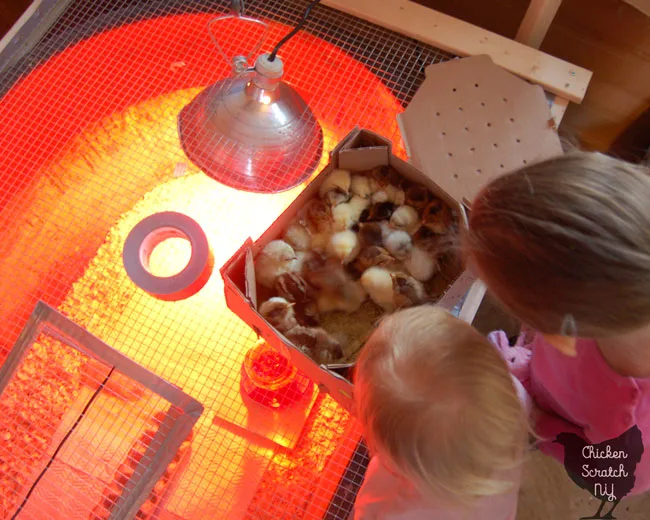
The first thing to do when identifying chicks is to get out the list of what you ordered. This time around I bought Silkies, Cochins, Welsummers, Easter Eggers, Speckled Sussex and Light Brahmas.
Read more about Setting Up a Brooder for Baby Chicks
When I ordered the Surprise Box from Cackle Hatchery this process was much more of an adventure!
I ended up getting most of them right and it was really fun trying to figure out what everyone was. It’s much harder but these tips with help you narrow down what you’re dealing with.
Start with Size
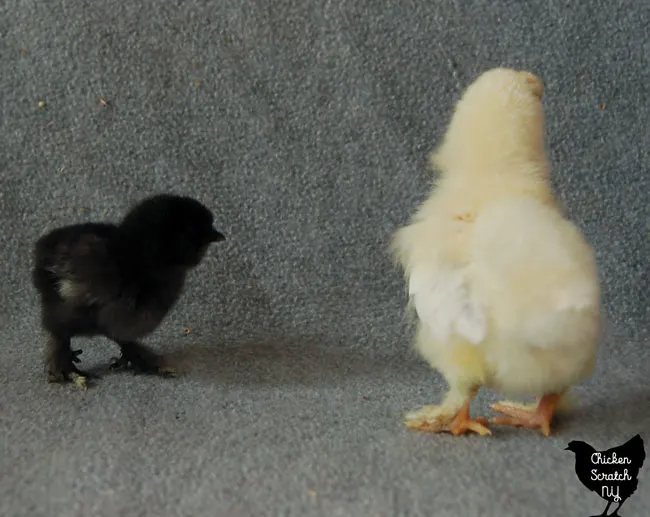
When it comes to day old chicks you’ll have two size options. Standard chickens have larger chicks than bantam chicken breeds.
The black chick is a bantam, the uncooperative white chick is a standard size. It’s actually a Brahma, which are the biggest chickens I have and they’re also my favorite chickens.
The only bantam breeds I have this time are Silkies. Silkies are pretty easy to pick out for a few reasons but wanted to show the size difference between standard and bantam chicks.
Read more about Bantam Chickens
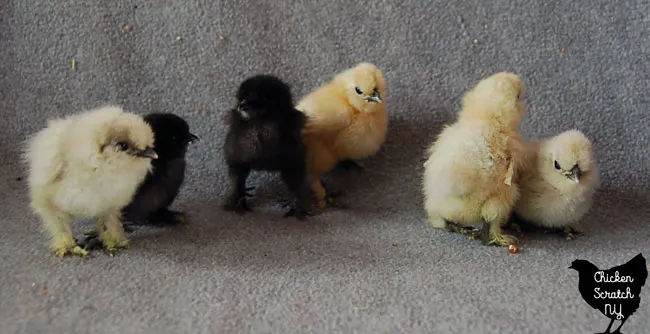
These are my little Silkie chicks. The two black ones are smaller than the others but they all seem equally healthy. I originally thought the others were going to be white but now they’re looking more like Splash Silkies on the lighter end of the spectrum.

After three weeks they don’t look that different, just a little bigger. Part of the fun of Silkies is the very fine, almost fur like feathers they have. Don’t worry, I didn’t lose one, they just get harder to photograph and less cooperative as they age.
I ordered 5 but ended up with 6. When you buy chickens online you occasionally get sent a few extra. This time Cackle Hatchery sent me 34 chicks instead of 30.
Read more about Ordering Chickens Online
Look at the Feet
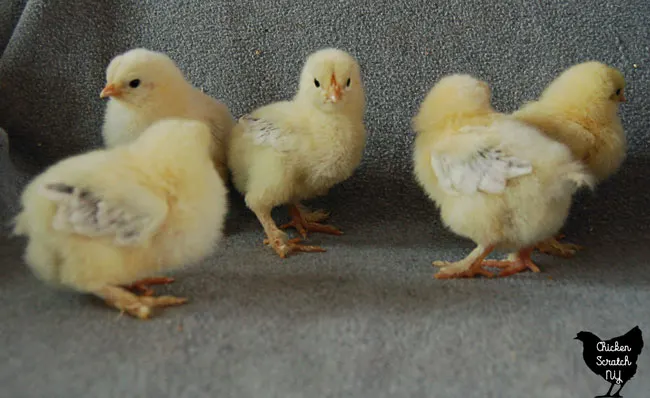
When you look at each chicks feet you’re looking for two main things. One, are there feathers? If the breed is ‘feather-footed’ it’s going to have fluff on it’s feet as a chick.
The opposite is ‘clean legged’. I had a 50/50 split on this one. My baby Brahmas, Cochins & Silkies are all feather-footed. The other three are clean legged. These are my Brahma chicks, you can see the light gray on the wing feathers along with the feathered feet.
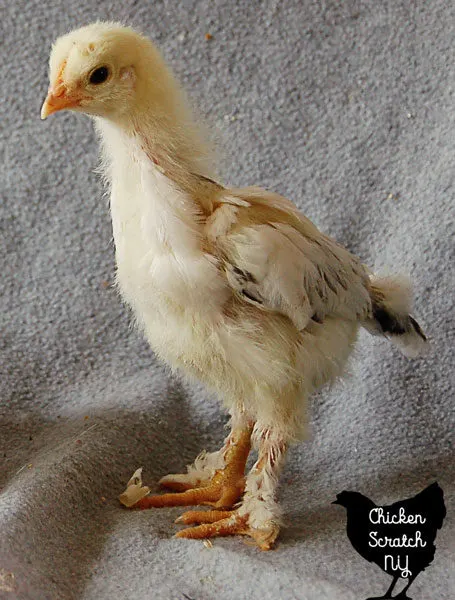
This giant is only three weeks old. Brahmas are big birds and you can already see the size difference. You can also see the grey patterns coming in and the leg fluff turning to feathers.

This batch of fluff is all Cochin chicks. The only thing that really sets them apart from the Brahmas at this age is the coloring. I’m really looking forward to seeing what the two darker ones on the left looked like.

This is the the darker two now. At three weeks old you can see they’re a bit smaller than the Brahmas, well I can. I didn’t take a picture of the two together but you’ll have to trust me 😉
I don’t have any laced brown birds so I’m excited for this one. They turned into beautiful Golden Laced Cochins, I call them my Halloween chickens
View this post on Instagram
When you’re looking at the feet you should also check out the leg color. I was able to identify my Appenzeller Spitzhauben chicks based on their slate blue legs and tiny head pouf.
Silkies have black skin, black feet and extra toes. Even if you didn’t notice the tiny size that’s pretty hard to miss 😉
One more foot feature to look for is an extra toe. Extra toes aren’t that common in the chicken world. You’ll only see that with Silkies, Sultans, Faverolles, Dorkings and Houdens. If you have a chick with an extra toe that’s a huge clue!
Check the Head

Chickens with top knots of feathers will have little pouf balls on their heads. If you have a chick with a tiny pom-pom it’s either a Polish, Spitzhauben, Houden or Silkie. I’m sure there are a couple others but those are the main suspects.
Another characteristic to check for is cheek poufs. The most common cheek pouf variety is the Easter Egger. EEs are pretty much mutts. They’re bred from Araucanas. These are the chickens that lay the pretty blue and green eggs!
Read more about Easter Egger Chickens
The four above are some of the Easter Egger chicks I received. They’re a variety of colors and hopefully they’ll lay a nice variety of egg colors. I love having these ladies around to add some color to all the fresh eggs I get.
You can tell they’re EE’s because of the extra fluff on the cheeks, it sort of gives them a double chin effect haha.
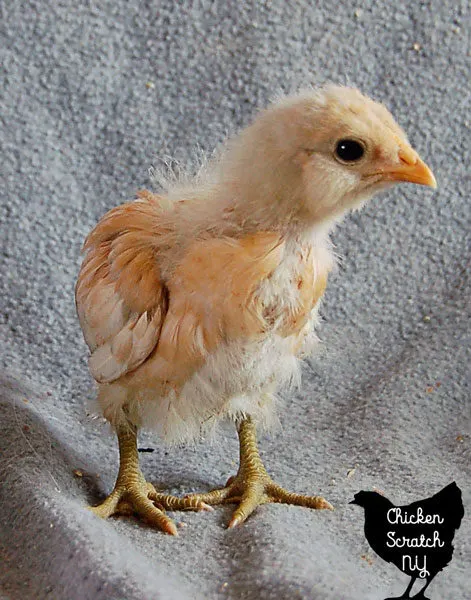
At three weeks old you can still see the poofy cheeks. I’m really happy with this chicks buff coloring. Most of my birds are black and white or dark brown. I do have one older EE hen that looks pretty similar to this and she’s beautiful.
Color Pattern
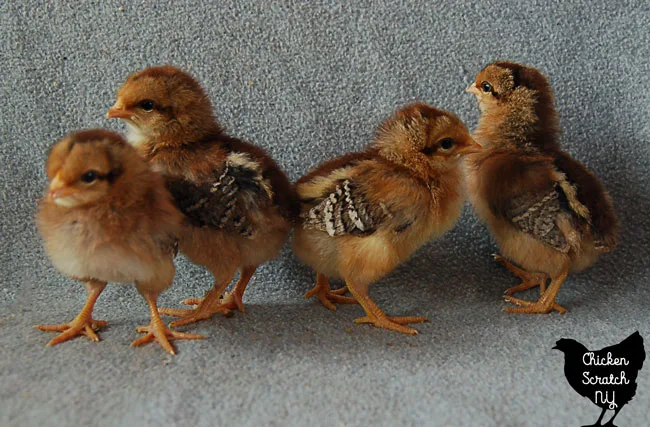
Color is probably the least helpful in identifying chicks, unless you only have two options and you need to narrow it down. If you order 25 white leghorns and 25 black austrolorps… Well, you probably don’t need to read this post!
When they first came in I couldn’t tell the Speckled Sussex from the Welsummers. They’re both the very common ‘chipmunk’ color pattern. Now, after a few weeks it’s getting more obvious.
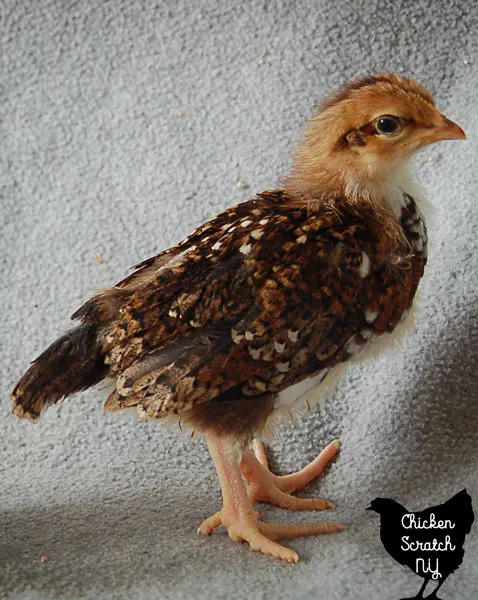
Looking back and comparing to now, I think the Speckled Sussex had a bit more white on the wings. You can see at three weeks they still have the ‘eyeliner’ going but most of the fluff is gone and the feathers are starting to show their patterns.
About half look like this one (Speckled Sussex), the other half have way less white (Welsummer). I can’t wait to see how the Speckled Sussex look full feathered and matured.
Egg Shell Color
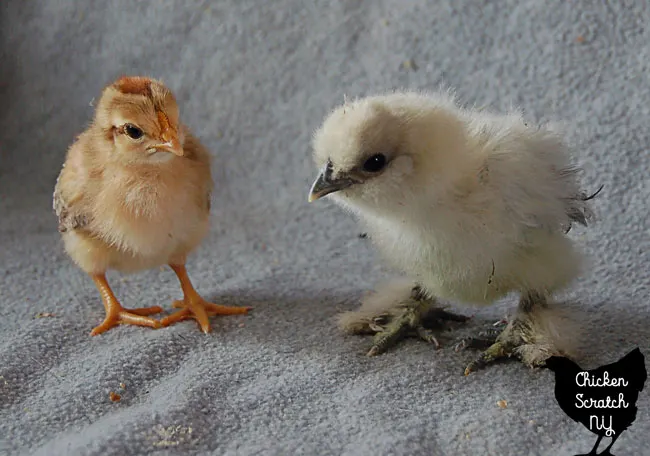
This one is only helpful if you hatch the eggs and know what shells the chicks come from. In my quest for olive eggs I hatched out the darkest brown and bluest eggs hoping for a Welsummer/EE cross.
Had I planned ahead I could have penned up my Welsummer rooster with my EE hens but I didn’t. It worked out though I did have a hen laying beautiful olive eggs.
If you follow me on Instagram you might have seen the Appenzeller Spitzhauben hen that went broody. She hatched one chick and I stole it from her.
It was freezing and wet outside, she also has a terrible track record as a mom! The little tan guy is about a week younger than the others. It’s the same size as the Silkies right now.
I’m sure it’s a rooster (it was!) because that’s how life goes on a farm. I think it’s part Welsummer, part… I don’t know but I’m pretty sure it came from a tan egg.
I do have a lot of birds that lay tan eggs so there are a few options and I might get a better idea as time goes on.
At this point I have so many types of chickens and a few generations of crosses that it’s anyone’s guess. I have ended up with some really pretty birds over the years.
One of my favorites was a Buff Orpington X with something that gave him gorgeous blue feathers in his tail.
I hope these tips help you with your own flock, whether you buy them or raise your own barnyard mutts.
Don’t forget to PIN this to your Chicken or Homesteading board for later, you never know when you’ll need to play barnyard sleuth!
Check out my Chicken page for more ideas or start with these:

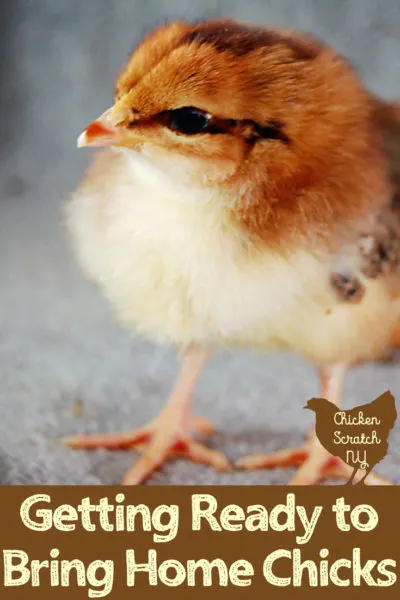
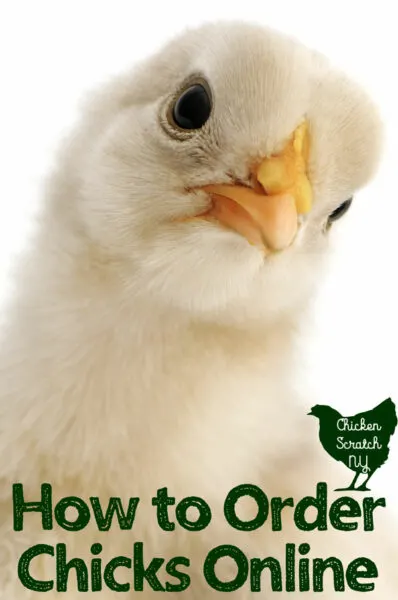


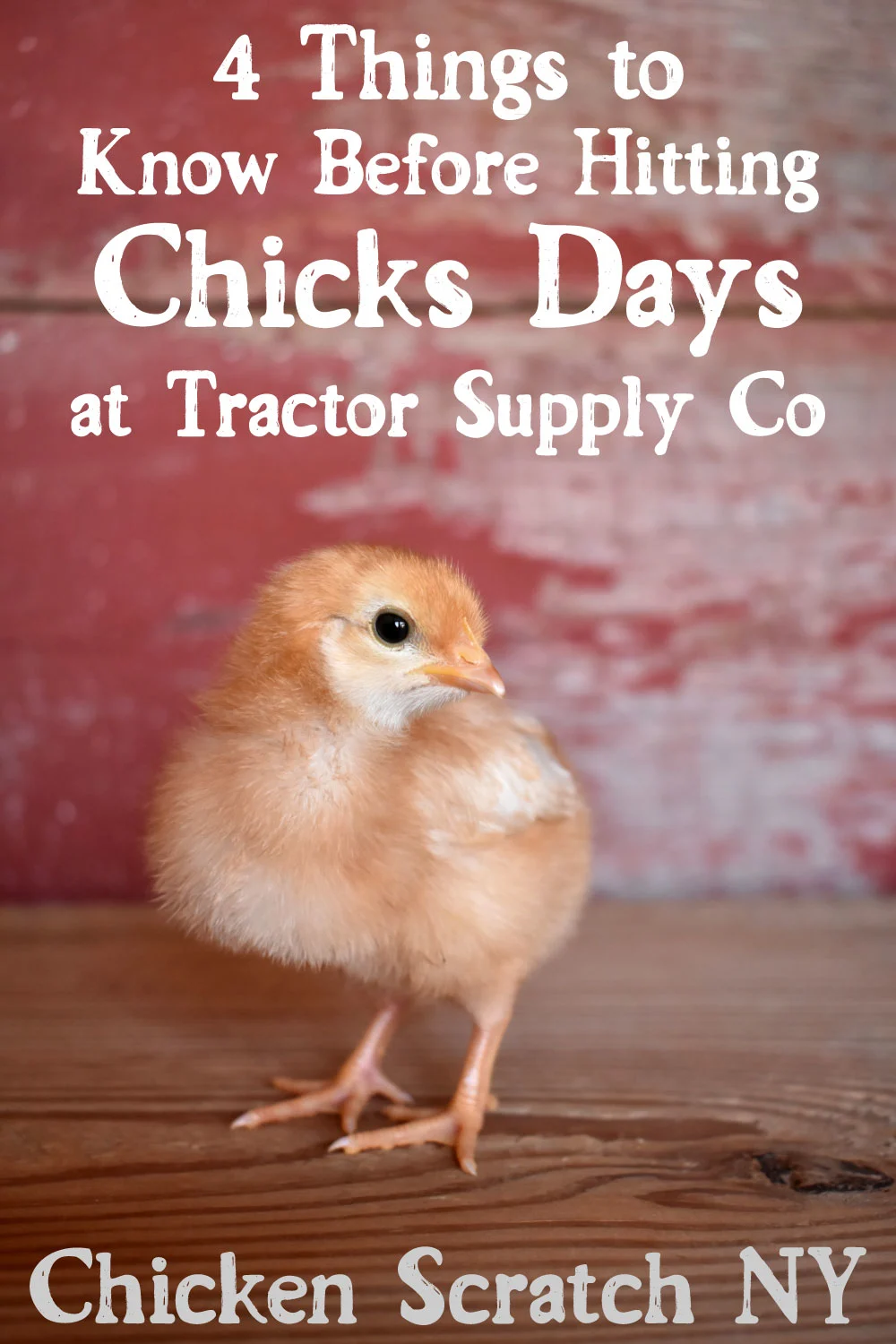
Brenda Boyle
Tuesday 18th of June 2024
I enjoyed your post and info. Pic's are great!
Beverly Walker
Saturday 15th of April 2023
What is the brown chick picture with all the same and little stripes in their feathers and a line down their back and under eyes! ?!!
Alecia
Monday 17th of April 2023
The chipmunk pattern is very common in chicks and is found in several breeds. Welsummers, Speckled Sussex & Brown Leghorn chicks are just a few options. Once they start to get more of their feathering and adult coloring in it is easier to tell.
Jon
Monday 12th of September 2022
We bought a dozen Easter Eggers/ Auraucana late spring. One of them was clearly different as she got older. Care to give it a shot and identify her? Maybe she is a cross?
Alecia
Wednesday 14th of September 2022
I can try my best! You can send it on IG to @aleciacsny or to alecia@ chickenscratchny.com (without the space)
Theresa Campbell
Thursday 30th of June 2022
I'm an 8 year chicken mama but still found your post informative. I raise Silkies, cochins, mostly, and in every color pattern known to man, Marans, Auracanas, Australorp, polish,and lately the amazing Sapphire Gem. I know I left someone out but you get that I have a variety,. What brought me here was trying to determine what the chipmunk patterned chick is that I got in what was intended to be a batch of possible fertile Sapphire eggs from my neighbor. I also enjoy researching my hatchling and as they mix more with every hatch, it's my belief they get more beautiful. Great article though, I enjoyed the photos of your kids greatly 😀
Kathryn
Thursday 22nd of February 2024
@Theresa Campbell, I also had silkies! They were so cute, and they laid eggs about once a day.
Ida Schroeder
Thursday 5th of August 2021
I purchased a group of Batam chicks known as a hatchery special collection ,, was told it was a popular collection and like by many of their customers! I went ahead with the order but,,, these are not what I thought I was asking for! I wound up with at least two roosters, pretty, but rowdy! A pint size and one twice the others size, had to remove them from our brooder pen, they were try to take the females tooo early, lot of squealing and squalking going on! The immature hens were not ready for the “haunching”! Also wound up with 6 black Cochins chicks of which I’m suspicious of 3 being “roosters “ so far I’m guessing I got possibly 5 “roosters “ out the back of 12 chicks! I wanted calm, friendly, chicks of some variety, but this mixture is crazy,, I haven’t a clue to what I got! I’ve called to inquire, but apparently they don’t know what the shipping department sent and I have to wait till that person returns next week to “maybe “ help identify these 3 month old Bantus by the pictures I’ve sent to their website. I’m rather disappointed in the collection and very dissatisfied with their customer service,,,no help at all, just a complete run around! Going to try a different hatchery next time and order exactly what I want! Beware of collections! They are the eggs that are pulled and not sold and they go into a “special collection bin” and they lower the price to get rid of them ! Beware of “Specials”
Ida Schroeder Sims, AR
Alecia
Friday 6th of August 2021
5 out of 12 isn't bad for straight run! Most hatcheries I'm aware of don't sex bantam chicks because they're so tiny and the best you can hope for is 50/50.
Cochins are pretty calm birds, hopefully the bantams have the full-sized personalities! The more 'game' type birds are usually flighty with a wilder attitude. I can't guarantee any thing but if you email me the pictures [alecia @ chickenscratchny.com without the spaces] I might be able to help you out